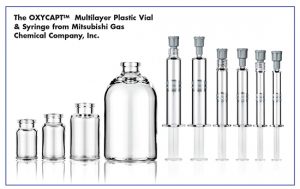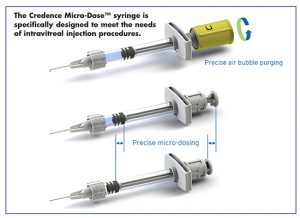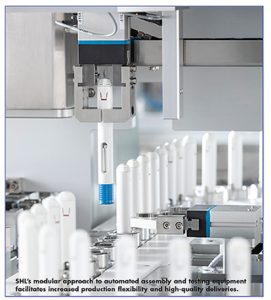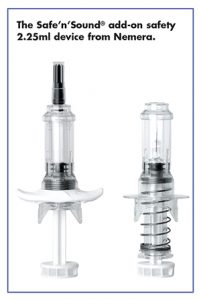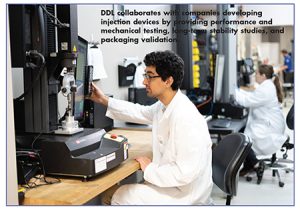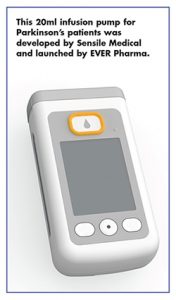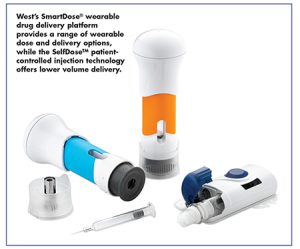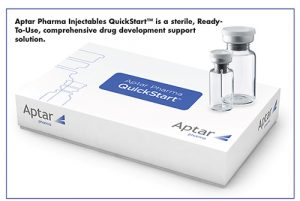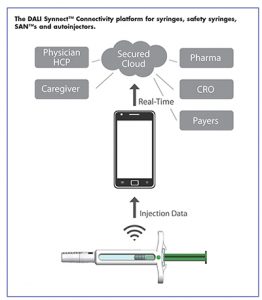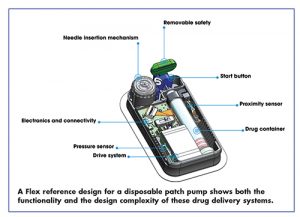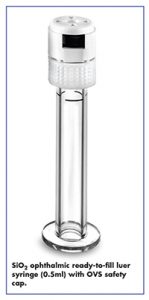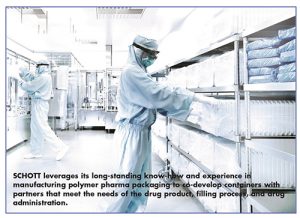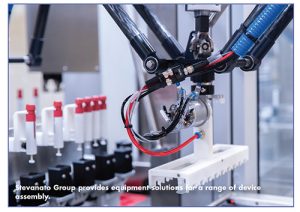Issue:September 2019
SPECIAL FEATURE - Injection Devices: Wearables, Connectivity & Patient-Centric Designs Empower Self-Administration
The global self-injection devices market is expanding at a rapid pace due to high prevalence and incidence rate of chronic diseases, technological advancements, new product development and commercialization, and product differentiation strategies adopted by leading pharmaceutical companies worldwide. In terms of revenue, the global market was valued at $3.7 billion in 2017 and is projected to reach $11.3 billion by 2026.1
“The high numbers of new injectable drugs projected to reach the market in the coming years, as well as the trend to move therapies from clinics into home settings to save costs and provide more convenience for patients means increasing demands for injection devices,” says Hans Jensen, Global Business Development Director, Consort Medical, Bespak Drug Delivery Devices.
The global self-injection devices market is also driven by a significant rise in demand for home health care, owing to low cost of treatment and improvements in overall patient experience. The ability of self-administration is a key factor fueling demand for pen injectors. The pen injectors segment held a significant share of 67.6% of the market in 2017 and research indicates that it is likely to be the leading product segment, owing to the applications in diabetes, easy availability, and low cost, according to a report from Transparency Market Research.
Technological advancements in self-injection devices, especially in autoinjectors and wearable injectors, for the administration of high-viscosity and large-volume drugs represents a potential business development opportunity for leading players. Reports suggest that the wearable injectors segment is projected to expand at a CAGR of 20% between 2018 and 2026.1
“Traditional spring-based autoinjectors have previously been sufficient to deliver the drugs being developed, however many biologics by nature need higher doses to have an effect, which leads to higher viscosities and/or higher volumes to be delivered,” says Mr. Jensen. “Furthermore, others are working on viscous long-acting formulations to decrease frequency of injections, thereby increasing patient convenience. Finally, a number of drugs initially developed for IV administration in clinics are being re-formulated to allow home administration, but that also can result in high viscosity and/or higher doses that may not be appropriate for traditional autoinjector devices.”
This exclusive Drug Development & Delivery report highlights the innovation in injection devices – from wearables to connectivity to varied dose administration – that have occurred in the past year.
Mitsubishi Gas Chemical Company, Inc.: All the Benefits of Glass & Plastic Without the Drawback
Traditional glass and plastic materials for syringes and vials are filled with problems. Glass suffers from a range of issues – such as high-breakability and poor PH stability – while plastic has an insufficient oxygen barrier and UV barrier. This led to the creation of OXYCAPTTM, Mitsubishi Gas Chemical Company’s new, lightweight, multilayer material.
OXYCAPT unites the best qualities of glass and plastic in a three-tiered, multilayer, advanced material that features a water vapor layer made from COP (Cyclo Olefin Polymer) and a glass-like oxygen barrier layer with an oxygen-absorbing polymer. With low extractables, low protein absorption, and low breakability, all components come together to produce a high oxygen barrier material.
“We have received a lot of inquiries about ready-to-use plastic vials because more pharmaceutical companies have installed aseptic filling machinery,” says Tomohiro Suzuki, Associate General Manager, Mitsubishi Gas Chemical Company. “We have tried to reduce the total amount of silicone oil to prevent protein aggregation, and have made plastic vial and syringes with a high gas and ultraviolet barrier to solve the problems about breakage and delamination of glass.”
BD Medical – Pharmaceutical Systems: Responding to the Evolving Biologics Landscape
Biologic therapies that are in development now to treat chronic diseases are raising the bar for injection technologies. The high-dosage, high-volume, high-viscosity formulations in development can create usability challenges in terms of handling comfort and force exerted. Total system integration — where all parts in drug device combination products operate seamlessly together to deliver reliable performance – can be especially challenging with these formulations. Further, patients’ and healthcare providers’ level of sophistication and expectations for the injection experience are evolving. Fluidity characterizes this industry, and biopharmaceutical companies must adapt quickly to the changing environment.
“The availability and variety of device platform technologies is also expanding,” says Beth DiLauri, Global Marketing Director at BD. “It’s an exciting time for the industry and BD is integrating all these dynamically changing needs and requirements into our portfolio of high-volume, high-viscosity solutions for biologic therapies. We address emerging pharmaceutical needs with platforms that are in development such as BD InteviaTM autoinjectors, BD LibertasTM wearable injectors, and BD UltraSafe PlusTM passive needle guards.”
To achieve the flexibility desired by its customers, the BD NeopakTM prefillable syringe technology for biologics is integrated into BD’s delivery solutions to achieve high performance and enable choice of platforms to serve various end-user and therapeutic needs, says Ms. DiLauri.
BD is also actively investing in smart options that enable connectivity to address the changing needs of the healthcare ecosystem. For example, BD LibertasTM smart technology utilizes a modular approach through a customizable top case that incorporates sensors and electronics, providing pharmaceutical companies with an optional technology that can offer smart features, or not, depending on the needs of patient populations and therapies.
Credence MedSystems, Inc.: Overcoming the Challenges of Intravitreal Drug Delivery
With approximately 1.3 billion people worldwide victimized by some form of blindness due predominantly to macular degeneration, diabetic retinopathy, ocular vein occlusions, endophthalmitis, and retinitis, 2 and with the booming growth of the over-65 population from 630 million today to 1.2 billion in 2030, the pharmaceutical industry’s focus on therapies delivered via intravitreal injection continues.3 This is leading to a forecasted growth in the intravitreal injectables market of 4.8% CAGR from 2018 to 2026.4
As with any therapy, delivery systems for intravitreal injections should seek to minimize safety risks, facilitate administration of the correct dose, and minimize disruption to pharma’s established processes, says John A. Merhige, Chief Commercial Officer, Credence MedSystems, Inc., which has developed the Micro-DoseTM Syringe System. Mr. Merhige says the design of Micro-Dose reduces the unwanted variability during use that can lead to patient risk. “Intravitreal injections have specific challenges related to the sensitivity of the injection site and the extremely low dose volumes, which are in the 50μL range for conventional indications and even lower for newer therapies,” he says.
For example, air injected into the eye causes significant pain for the patient. With Micro-Dose, the clinician purges the air bubble in a controlled manner by turning the safety cover until it automatically detaches, revealing the thumbpad. In addition to adding a greater level of certainty that the air will be purged, this process eliminates the drug spillage that can occur in conventional debubbling from overcoming the plunger break-loose force. With such low volumes, any significant spillage will lead to underdosing, says Mr. Merhige.
“The conventional procedure is further susceptible to mis-dosing due to its inherent variability,” he says. “With the conventional injection process, the clinician is required to eyeball the correct dose by attempting to place the plunger adjacent to a dose line on the syringe,” he explains. “This variability leads to the risk of under or overdosing.”
With Micro-Dose, the clinician simply presses on the plunger rod until it stops moving. The permitted travel length of the plunger rod determines the dose ‘by design,’ enabling an extremely precise delivered dose. Additionally, Micro-Dose allows the clinician to achieve a comfortable grip, unfettered access to the injection site and efficient completion of the procedure.
The system is compatible with conventional needles or can incorporate Credence’s proprietary needle-retraction system. An additional option exists to include a feature that reduces the user force required for injection of viscous products. Mr. Merhige adds that Micro-Dose has been designed to allow implementation without disrupting already validated primary package choices or manufacturing operations. The design incorporates few additional components and is compatible with any prefilled syringe. Secondary assembly on already-filled syringes is straightforward in implementation on existing processes.
Enable Injections: Wearable Infusor Platform for Larger Volume Drug Delivery
Biologic therapies often start with intravenous infusion and require large volumes for efficacy. Transition to subcutaneous delivery may require even higher volumes due to bioavailability. These large volumes are not suitable for administration via autoinjectors and prefilled syringes. Infusion pumps capable of delivering large volumes are available for subcutaneous delivery in the home, but they are complex, and often require in-home infusion services for administration.
“Enable Injections believes that patients will benefit, and pharmaceutical companies will be able to differentiate products, from a patient-preferred, on-body infusor platform,” says Jennifer King, Marketing Manager, Enable Injections. “Our goal is to move patients out of the clinic for drug administration, reducing the cost of healthcare and potentially improving patient quality of life.”
The enFuse®, developed and manufactured by Enable Injections, is an on-body infusor that has been designed with the patient in mind. The enFuse technology has an elastomeric balloon that acts as the storage reservoir of the therapeutic as well as the power source for the infusion. The size of the infusor is minimal and allows a larger wearable volume for the patient, says Ms. King. The enFuse utilizes standard container closure systems for point-of-care filling.
The enFuse is being developed to accommodate subcutaneous infusion volumes of up to 50ml of biopharmaceutical or pharmaceutical therapeutics. The enFuse contains no electronics, and infuses via constant pressure from the elastomeric balloon.
The next-generation enFuse will incorporate Bluetooth technology to provide a tool for patients to plan for, and track, infusions on their smartphone. “The technology design is planned to include remote patient monitoring, which may have the potential to improve treatment adherence,” she says.
SHL: Scalable Device Manufacturing for Variety of Production Volumes
The development of biologics and biosimilars has opened up avenues for personalized medicine: treatments targeted for niche disease cohorts with higher precision for enhanced treatment outcomes. With some of the first tumor necrosis factor (TNF) alfa inhibitors going off patent, the autoinjector market is expected to grow in overall size but diversified into several drug products. This means that device providers are now being challenged to produce autoinjectors in a variety of manufacturing volumes – ranging from several hundred thousand to several million devices per year for a single project – in different levels of customized or bespoke industrial designs.
Because most autoinjectors are designed for low- to medium-volume production, this paradigm shift calls for flexibility. Owning the full range of development and manufacturing capabilities in-house, SHL meets the challenge for scalable production through a modular approach to both the design of the autoinjector as well as the design of the assembly and testing machinery.
SHL has adopted a modular, multi-device strategy for its automated equipment. This approach makes it possible for components such as fixtures and grippers to be interchanged so that a variety of devices, or several different versions of the same device, can be operated on the same machinery. “Modularized automation not only enables scalable production, but it also improves quality, consistency, and accuracy because it decreases variation caused by human handling and facilitates a repeatable process that can be utilized in several production lines,” says Magnus Fastmarken, Director of Marketing, SHL. “By interchanging several components on one singular equipment, or strategically mixing and matching different module types, SHL ensures the reusability of a modular system for the vast and often varied forecasts for clinical or commercial needs.”
The evolution of the Molly® autoinjector is an example of how SHL is meeting the trend for scalable device manufacturing through its designs. Molly is a preconfigured autoinjector created to reduce costs and shorten development timelines. Molly is known for its easy-to-use, 2-step operation and compact design. And its production has been supported by SHL’s manual and semi-automated capabilities to fulfill low- and medium-volume requests.
Now, a second-generation has been developed with a new ergonomic design and a flange-shaped anti-roll cap for an easier handling experience. “For SHL, manufacturability is as important as functionality, which is why the design has also been optimized for automated production,” says Mr. Fastmarken. “This includes additional flexibility in sub-assembly and final assembly options, as well as an expanded scope for syringe choices.”
The first autoinjector based on the new Molly technology for high-volume production is already in development and is due for commercialization in 2020. To ensure the autoinjector design is seamlessly integrated with its production equipment, SHL’s cross-functional teams of industrial designers, assembly system engineers, tooling engineers, and molding operations collaborate closely. Fastmarken says: “This truly integrated approach to development and manufacturing makes it possible for us to scale volumes according to customer requirements, and develop completely bespoke devices based on customer needs.”
Nemera: Focused on Larger Volume Injectable Devices
Biologic drugs are often needed in high concentration: this can be driven by the nature of the molecule, composition of the final drug, and by the effort to decrease the frequency of treatment for the patient. Their viscosity increases as a power law of the antibody concentration. To be injected, these molecules need to be diluted, which leads to higher injection volumes, and lower (but still high) viscosity. As a result, volume is shifting towards 2ml.
Nemera’s focus has been on larger volume injectable devices; Nemera’s parenteral devices are specific to injecting large volumes such as 2ml and larger. The Safelia® autoinjector device can inject up to 2.25ml fill volume, with high viscosity. And in the past year, Nemera commercialized the Safe’n’Sound® add-on safety 2.25ml device. The single-use device helps prevent needlestick injuries and is compatible with prefilled syringes. And the Safe’n’Sound 2.25ml platform is suitable for low-fill volumes and higher viscosity formulations.
“Our 2.25ml size is specifically relevant to administer complex, high-value drugs such as monoclonal antibodies or other biological therapies,” says Severine Duband, Global Category Manager for Parenteral at Nemera.
Additionally, Nemera has been working to bring connectivity to devices, either as an add-on or in an integrated device. Its on-body injector platform, which is in development, incorporates this technology into a smart wearable platform. The platform in development is composed of a reusable and rechargeable part as well as a disposable part containing the drug, needle, and sticker patch.
Ms. Duband says key benefits include an adjustable flow rate, automatic needle insertion, and smartphone communication including treatment information, reminders, and compliance features.
“As a platform, is it highly customizable and flexible, and can adapt to any type of therapeutics requiring the injection of large volumes,” she says.
Noble: Training to Prevent the “Forgetting Curve”
The continued growth of self-injection therapies will lower dosing frequencies. While this improves the patient treatment experience by reducing the burden of self-injection, it also increases the risk that patients will forget the proper self-injection process due to training decay, says Joe Reynolds, Research Manager, Noble.
Noble’s patient training solutions are specifically designed to assist patients with overcoming the impact of the “forgetting curve” by allowing them to practice with a resettable training device that closely replicates the drug delivery process.
Noble has focused primarily on the development and manufacturing of platform demonstration training devices based on the BD UltraSafeTM, BD PhysiojectTM, and Ypsomed YpsoMate® injection devices. “Following the lead of these drug delivery device manufacturers, Noble has invested in platform demonstration devices that allow our pharmaceutical customers to bring trainers to market with greater speed and lower tooling investment,” says Mr. Reynolds. “Our focus is not only to design, engineer, and produce the highest quality training devices to improve patient adherence, but also to build a device launch strategy for commercial teams that ensures both a successful start and recurring long-term success.”
Noble is currently developing a training device to support the launch of the BD LibertasTM wearable device. Mr. Reynolds says: “As the demand for this wearable device grows, pharmaceutical customers who use Libertas to deliver higher drug doses will have the opportunity to deploy our Libertas demonstration device to ensure patients fully understand how to use these novel drug delivery devices.”
DDL, Inc.: Lab Addresses Dynamic & Analytical Testing
A common approach for drug development includes the use of ICH stability conditions to subject the product to varying environmental conditions. Subsequent stability pulls are tested against a battery of tests to ensure the safety, purity, and potency of the drug product. Take the case of an injectable biologic product. Depending on the firm’s risk appetite and the regulatory pathway, the initial GMP batches are filled in a vial or prefilled syringe, packaged, and carefully carted to the stability chambers for their iterative cadence of stability, followed by analytical testing. Acceptable stability profiles against the various product tests keep the program alive.
Fast forward to design verification, where the device portion of the combination product is put through the ringer. A common approach includes a bombardment of physical stressors on the final-finished package configuration, which simulates a variety of transit conditions one would expect for the mode of distribution chosen for the given product. The resultant units are commonly placed into ICH stability conditions where an iterative cadence of stability is followed by physical testing to ensure the functionality of the device. Such tests include mechanical testing, particulate analysis, and container closure integrity.
But this creates a gap. The early stage GMP batches put on stability are typically never subjected to physical stressors, from a dynamic perspective. During design verification, the product is subjected to physical stressors, from a dynamic perspective, but is not scrutinized from an analytical perspective. Furthermore, recurring stability studies during commercial production will likely not account for the stress put on the product during transit and distribution.
Injectable biologic products are some of the most sensitive therapies in development and on the market. Using the example of proteins, the efficacy of these highly complex molecules can sometimes depend on low-energy interactions such as hydrogen bonding and van der Waals forces. Subjection of these molecules to the harsh conditions of transit and distribution can alter their conformations, cause precipitation or aggregation, or accelerate degradation. By not testing the product against the analytical battery of tests after transit and distribution simulation, application holders run the risk of an adverse event occurring.
“R&D scientists and engineers should consider the dynamic component when executing stability studies, no matter the stage of development,” says Joseph Wojcik, Program Manager, DDL, Inc. “Additionally, biosimilar application holders should closely examine innovator package configurations when reverse engineering those products. Subtle choices of syringe placement, tray design, and carton design can impart differing forces onto the drug product within the device. Lastly, as biologic products evolve into pen-injectors for home administration, application holders ought to consider the conditions likely to occur between the pharmacy and the patient’s home refrigerator or freezer.”
Sonceboz: Mechatronics Enable Easy-to-Use Injection Devices
Sonceboz is developing a technology platform designed around a pump module that uses vacuum to gently withdraw liquid drugs from their respective containers before delivery into the subcutaneous space. This enables a high degree of compatibility to primary drug containers of different forms and capacities without the need to change the overall system architecture. The pump comes with multiple channels to allow for complex therapeutic applications, such as drug combination therapies or drug mixing and reconstitution, all within the embodiment of the device.
“The advantage of our approach is reliance on one proven system and thereby accelerated development and time to market,” says Thomas Mayer, Business Development Manager, Sonceboz. “These characteristics are important to providing a drug delivery platform that works from clinical trials to lifecycle management.”
The Sonceboz platform has built-in connectivity using Bluetooth Low Energy as the communications standard. “Because our drug delivery systems are electromechanical and equipped with smart sensors, we can provide a variety of data for transmission using connectivity,” says Mr. Mayer. “Depending on the needs of our pharma partners, we transmit information, such as time and volume of delivered dose.”
Sonceboz is also designing a platform of wearable injection devices: LVITM, DCITM, and ARITM. The LVI family comes in two different forms: cartridge based and either user loaded whereby the patient inserts a filled cartridge into the device prior to use or prefilled and preloaded with the drug container already installed in the device. The LVI-VTM can handle drug payloads up to 20ml and comes with a vial-adapter that allows for the automatic transfer of liquid drugs into the device. In that case, a temporary drug container is used inside the device for short-term storage. This device is intended for use during clinical trials.
The DCI device uses two cartridge containers simultaneously. This allows for combination therapies in oncology or when one wants to keep the existing drug container but double the delivered payload. The ARI is intended for automatic reconstitution of lyophilized drug products. A prefilled and loaded diluent reservoir is inside the device and reconstitute is in a connected vial, which is removed prior to attachment on the patient’s skin. “This simplifies the use of lyophilized products and supports self-administration,” says Mr. Mayer.
Sensile Medical: Wearable Pump Targets Parkinson’s Disease
A delivery device is defined by the drug to be administered, the treatment regimen, and the patient. Opinions of patient groups, healthcare providers, the patient’s physical condition, and the place of administration are all taken into account during early handling studies to address all stakeholder needs. No matter which patient group receives the device, Sensile Medical’s devices are tailored and customized for the individual patient group.
For example, the first micropump from Gerresheimer subsidiary Senile Medical is now available on the market. Developed by Sensile Medical especially for EVER Pharma under the brand name D-mine® Pump, this wearable infusion device with a micropump recently received European CE certification and has already launched in several European countries. “The compact, patient-friendly pump is used for the continuous subcutaneous administration of the drug to treat the advanced state of Parkinson’s disease, and may give patients more autonomy in their daily lives,” says Sandra de Haan, Chief Business Officer, Sensile Medical. “Considering the impairments caused by the disease, it was crucial to develop a device that is safe and easy to handle for those having difficulties coordinating their movements.”
Sensile also addresses the demand for technologies for eHealth applications and is working on connectivity solutions and sensor technologies as an option for device flexibility and modularity. “As our technology is driven and controlled by electronics, connectivity is straightforward to implement,” says Ms. De Haan. “These electronically controlled devices offer a variety of options for dosing that are pre-set or adjusted by healthcare providers or patients.”
West Pharmaceutical Services, Inc.: Wearable Platform, Injection Technology Empower Patients
In the biologics space, there is a clear trend toward higher delivery volumes, less frequent dosing, and the conversion from intravenous to subcutaneous delivery. This is driving demand for wearable technologies. West’s wearable solution is the Smart-Dose® drug delivery platform. West has commercialized the SmartDose Gen I 3.5ml device, and will soon bring a higher volume SmartDose device to market, supporting delivery up to 10ml.
SmartDose Gen I 3.5mL is a device with Amgen’s Repatha, where it provides a single, monthly dose delivery option. Gen II incorporates technical and human factor improvements and supports up to 10ml delivery. “Our SmartDose devices can address multiple disease states from oncology and autoimmune to CNS, and empower patients to treat themselves in the comfort of a clinic or their own home vs. a hospital setting, with fewer injections than a multiple autoinjector alternative,” says Aileen Ruff, Senior Director, Strategic Marketing, Biologics, West Pharmaceutical Services, Inc.
scPharmaceuticals Inc. announced its intent to go to market with West’s 10mL SmartDose® device for FUROSCIX®, a proprietary furosemide solution for treatment of edema in patients with congestive heart failure. FUROSCIX is formulated for subcutaneous delivery, and West’s SmartDose wearable drug delivery technology provides an outpatient alternative for the treatment. Alexion has also announced its adoption of SmartDose for two blood disorder products. ALXN1210 utilizes the Gen I 3.5ml SmartDose device to help eliminate up to two hospital visits per week for patients.
“To further strengthen the offering to our customers, early in 2019, West and Swissfillon announced a partnership for an integrated solution for clinical filling of SmartDose Drug Delivery Platform Cartridges,” says Ms. Ruff. “Taking away possible challenges in the supply chain around upscale of fill-and-finish activities contributes to a smoother journey to approval for our pharma clients.”
West also partnered with Accord Healthcare Limited to develop a delivery device for a weekly single-dose injection of its drug MethofillTM (methotrexate) SELF INJECT. The incorporation of West’s Self-DoseM technology supports the required dosing level and ergonomic design, which allows Rheumatoid Arthritis patients with dexterity issues to self-inject outside of a healthcare setting. West’s SelfDose patient-controlled injection technology is for volumes lower than 3.5ml.
Haselmeier, Inc.: Injection Pen Administers Single-Fixed & Multiple-Select Doses
The continued growth of new biologic therapies, biosimilars, and other novel drugs combined with a shift towards self-administration of these therapies outside of a clinical setting, mostly at home, is creating an increased focus on the design, effective use, and safety of the drug delivery system. Haselmeier, Inc. views these trends as an opportunity to apply patient-focused design and development processes to the next generation of injection systems. The most recent result of this patient-centered development process is the D-Flex Injection pen.
D-Flex is a manual injection pen platform for the administration of a small number of selected doses. In some therapies, treatment specifies a finely adjusted variable dose. “Typically, a variable dose injection pen will be used for that kind of application, however, those injection devices have a myriad of injection volumes for the patient or healthcare practitioner to accurately use,” says Terence O’Hagan, General Manager, Haselmeier, Inc. “Too many choices represent a significant potential use error in applying the wrong dose.” Other therapies may require just one fixed dose and a fixed-dose injection pen is used. Mr. O’Hagan says these pens are limiting in use. “The D-Flex manual injector pen platform brings the worlds of fixed-dose and limited-variable dose pens together with a device that makes it easy to select one fixed or several fixed doses on the same device, and includes a mechanism that prevents the selection of unintended doses.”
Haselmeier, in cooperation with Common Sensing, announced a connected D-Flex injection pen that can be paired via Bluetooth with a smartphone. Called D-Flex Connect, the reusable pen cap replaces the standard cap, so the patient has the advantage of already being familiar with the use of the device, says Mr. O’Hagan. In addition to providing the date and time of an injection, D-Flex Connect provides the actual dose volume delivered by the patient while also advising on remaining volume in the cartridge. “This information provides a clear picture of the patient’s treatment status, while having the capability to communicate this information to selected stakeholders about their treatment including family members, caregivers, and physicians,” he says.
Aptar Pharma: Setting a Standard of Cleanliness in Elastomeric Components
From increased regulatory requirements to internal development of extremely sensitive drug formulations, Aptar Pharma’s clients look to the drug delivery provider to support these needs. This is most evident in the company’s quality control process offering, PremiumVisionTM. This in-line, automated vision inspection system validates against critical defects in elastomeric components. “We are actively setting new standards for particulate reduction and molding consistency with PremiumVision,” says Adam Shain, Director, Global Business Development, Aptar Pharma, Injectables. “We have invested heavily in PremiumVision across all three of our manufacturing sites – two in France and one in the U.S. – because it is critically important in the delivery of more sensitive and expensive drugs, including complex proteins.”
Aptar Pharma is also focused on helping its customers get to market quickly. To support this, the company developed Aptar Pharma Injectables QuickStartTM, a sterile, Ready-To-Use, comprehensive drug development support solution designed specifically for universities, start-ups, and customers’ R&D labs. “The components satisfy all regulatory requirements, delivering commercial-scale quality at a development stage cost and reducing bench-to-market time,” says Mr. Shain.
With regard to its own portfolio, Aptar Pharma has connected devices and is actively looking for opportunities related to wearable technology. “Connected medicines hold great promise for improving medication adherence, reducing healthcare costs, and, ultimately, improving patient outcomes,” he says. And, while we do not currently offer an off-the-shelf wearable solution, our elastomeric components are utilized by wearables manufacturers.”
Consort Medical – Bespak Drug Delivery Devices: Faster Delivery of Viscous Drugs
Consort Medical – Bespak Drug Delivery Devices has developed a range of delivery devices specifically targeting high-viscosity drugs and higher delivery volumes. “Consort believes these are a game changer for the industry, which has not previously considered this to be an option, and have instead aimed for lower viscosities in their formulation work or selected more complicated and expensive body-worn delivery devices to deliver higher volumes,” says Hans Jensen, Global Business Development Director, Consort Medical – Bespak Drug Delivery Devices.
Viscous drug delivery with minimized needle insertion pain is enabled with Consort’s VapourSoft technology, which uses liquified gas instead of conventional springs in delivery devices such as the Syrina AS autoinjector. Syrina AS targets a range of biological drugs, such as monoclonal antibodies as well as depot or long-acting formulations of small-molecule drugs. Mr. Jensen says: “The device is designed in a way that makes it easy to modify to meet specific customer requirements.”
Initially developed to deliver 2ml of a 50cP viscous drug product in less than 10 seconds for a specific version of a PFS, customizations to the device can be made in just a few weeks to deliver fully functional devices based on a client’s specifications for ISO 11040-compatible 1ml- or 2.25ml-prefilled syringe (glass or plastic), drug viscosity, fill volume, needle size, and delivery time, he says.
DALI Medical Devices: Connectivity Keeps All Interested Parties in the Loop
While the global homecare market promotes convenience while reducing medical care costs, the trend is taking its toll as home-medicating patients need to be closely monitored for their adherence to treatment. This need becomes even greater for companies conducting a clinical trial that involves a large number of patients, scattered over remote locations, resulting in a complex study follow-up.
DALI is currently developing the SynnectTM platform to address these monitoring needs. Synnect will be an add-on device fitted to standard and safety syringes or to DALI’s SANTM (Safe Auto-Needle) products, as well as to autoinjectors. This platform transmits real-time injection data to a dedicated smartphone app that uploads the data to a secured cloud. Unlike other connectivity injection devices, Synnect senses the injected volume not just injection completion, says David Daily, MSc, MBA, CEO & Co-founder, DALI Medical Devices Ltd.
“An effective clinical study monitoring could significantly reduce the clinical studies drop rate (currently ~30%), as fewer patients would be excluded from the study,” says Mr. Daily. “On top of that, home treatment would ease patient recruitment, as it spares the hassle of clinic appointments.”
In addition to the Synnect platform, DALI is introducing the SAN product family. These products combine automatic needle insertion, similar to automatic injectors, as well as manual control over injection speed, similar to standard syringes, he says.
The current focus of DALI’’s team has been the SAN-L, which is under final development stages. SAN-L is an automatic needle designed to fit all luer-lock syringes. Features include truly hidden needle, automatic needle insertion for accurate needle penetration, and passive safety sharps protection.
Another member of the SAN family, the SAN-Light safety needle was selected by a European pharma company for help with an injection device for its biological drug, which is highly viscous and challenging for intramuscular injection. To solve this problem, the DALI SAN-Light safety needle has been carefully customized: a larger needle has been selected to enable continuous drug flow, and the device fitting has been redesigned to connect to a unique syringe. The customized SAN-Light has passed its verification and validation, and is expected to be launched to the EU market in 2020.
Flex Health Solutions: Designing & Manufacturing Connectivity & Wearability into Injectors
Freedom from user error is paramount and Flex Health Solutions incorporates specialized expertise in needs analysis and human factors in the design process. Flex’s design and manufacturing involvement in various industries has allowed the company to transfer its knowledge in connectivity to healthcare, explains Patty Kamysz, Marketing Manager, Flex Health Solutions.
One critical area is low-cost modules for single-use disposable devices, where such technology was previously cost prohibitive, she says. Flex partners with pharma companies to help them choose the right kind of connectivity and to advance them to the next step in drug delivery, providing patient compliance monitoring and enriched drug delivery through feedback and analytics. Flex has been focused on various injection devices including pen injectors, autoinjectors, wearable injectors, and disposable and reusable devices. The therapeutic applications Flex is targeting are diabetes, cancer, arthritis, and other autoimmune diseases.
“Flex has a solid track record in designing and manufacturing complex electromechanical autoinjectors – especially the current market where pharma is aggressively targeting biologic solutions that make simple autoinjectors impractical due to the high viscosity and large volume,” says Ms. Kamysz. “We simplified the device interactions by using electrical motors rather than relying on the patient’s ability to inject. Patients are now equipped with tools that guide them through injection via dynamic user interfaces.”
Ms. Kamysz says Flex recognizes the importance of wearables as a new category for drug delivery devices. “We developed a platform device that allowed us to tackle some of the most complex challenges: how to integrate a prefilled industry standard primary container to eliminate patient filling; creating low-cost solutions in connectivity for compliance monitoring that integrates into a full health cloud solution; sensor integration to indicate positioning and contact; and minimizing form factor for connectivity module and drive systems.”
Kahle Automation: Micro-Assemblies & Components for Wearable Injection Devices
As products are getting smaller and tolerances are getting tighter, this puts pressure on the automation suppliers and component suppliers to produce high-volume components at much tighter tolerances. These micro-assemblies and associated micro-components are crucial to the functionality of today’s complex drug delivery and diagnostic devices, states Julie Logothetis, President of Kahle Automation.
Kahle designs and builds automation equipment for micro-assemblies with production outputs ranging from 10ppm to 630ppm. Its knowledge includes the feeding and assembly of molded components, tubing, and cannula as small as 6mm long and 32G. Its equipment can integrate micro-dispensing, vision and leak testing, punching filters and diagnostic mediums, welding, and cannula bending.
Kahle recently completed several projects involving the assembly of the internal fluid path of wearable injection devices. “It is critical for these products to keep the fluid path patent even through the complex maze of tubing and bent cannula required to navigate the path within the internal working of the device,” says Ms. Logothetis. Kahle offers cannula bending technology that can bend 29G cannula up to 120 degrees while maintaining orientation of the ground sharp.
In addition, Kahle has provided the automation for the manufacture of an ocular injection device that will allow the practitioner to perform a precision injection in the eye to the exact point of treatment, she says.
Duoject: Improving User Safety & Compliance Through Product Design
During this past year, Duoject has been seeking ways to increase safety for prefilled syringe users. This involved reviewing all commercially available safety engineered syringes to better understand how they are used and how they currently address user safety, explains Dan MacDonald, Vice President – Engineering, Duoject.
“We realized that most existing technologies on the market have some drawbacks, such as exposed needles prior to injection, risks of cross contamination or requiring changes to the primary container in order to integrate the safety solution,” he says. “We set out to develop a new safety syringe technology addressing these issues. The device is designed to prevent sharps exposure potentially leading to end-user injuries, all the while optimizing the assembly process with standard unaltered PFS.”
Duoject is also working to enhance its portfolio in the areas of reconstitution and administration devices. Duoject has improved existing technologies and developed new devices, such as vial-to-cartridge, vial-to-syringe, and vial-to-vial reconstitution platforms. Duoject has also developed new cartridge- and PFS-based injection solutions. “These new developments were designed for homecare users and healthcare professionals, providing safe and intuitive single-use solutions to the end-user,” says Mr. MacDonald.
In addition to focusing on end-user safety, Duoject is also exploring opportunities in the area of connected devices aimed at improving treatment compliance. To that end, Duoject has developed and patented a mechanical injection detection system that, when triggered, sends a signal to a user’s smart device. Mr. MacDonald says the company plans to continue exploring this field, both in-house and through partnerships.
SiO2: Closing the Gap on Zero Particles in Prefilled Syringes
Particles are omnipresent in the manufacture, storage, and delivery of biologic drug formulations. There is universal agreement that particles provide no therapeutic benefit, and in many cases are detrimental to the efficacy and quality of biologic drugs. Worst case, adverse drug reactions, including death, may result in patients injected with particle-ridden biologics.
Product recalls associated with particles is an ongoing problem that has the attention of regulatory authorities. While the pursuit of “zero particles” may never be achieved, there is plenty of room for improvement. United States Pharmacopeia (USP) guidelines govern the acceptable visible and subvisible particle loads in pharmaceutical injections. The most recent quality guidance for ophthalmic drug products, USP <771>, sets the most stringent subvisible particle load limits for intravitreal injections according to USP <789>. All other extraocular injectables are subjected to limits that some argue to be too lenient (USP <788>).
“Primary packaging innovation is essential to closing the zero-particle gap, particularly subvisible particles,” says Christopher Weikart, Chief Scientist, SiO2 Medical Products (SMP).
SiO2 Medical Products took a leap toward zero particles with a hybrid ophthalmic 0.5ml prefilled syringe, says Dr. Weikart. The SMP syringe barrel is composed of a medical-grade cyclic olefin polymer (COP), internally coated with a silica-based barrier and lubricant coating system. The lubricant coating, a crosslinked organosilica, was engineered with lower subvisible particle loads than ordinary silicone oil lubricants without sacrificing plunger force performance or container closure integrity (CCI), says Dr. Weikart. “Key benefits include the use of standard plungers with sustainable CCI over the product shelf-life and particle loads up to 80% lower than USP <789> guidelines.”
The problem with too many lubricant particles in biologic drug formulations is aggregates. Some biologics (e.g. proteins) interact with lubricant droplets causing them to stick together. Bound proteins are unavailable for therapeutic action once injected into the bloodstream. Surface interactions with the syringe barrel can also generate aggregates. Proteins bind to the surface forming regions of protein stacking that can slough off into solution due to shipping, storage or delivery stress.
“Generally, fewer lubricant droplets means fewer aggregates, which has been observed with polyclonal antibody formulations stored in SMP syringes subjected to various stress,” says Dr. Weikart. “The hydrophobic chemistry of SMP coatings are engineered to minimize protein binding, which reduces the chance of aggregates.”
Just as microbial invaders trigger immune response and adverse drug reactions, aggregates can have the same effect. The triggering system, called complement activation, involves proteins signaling killer cells to the battle. “Accelerated freeze-thaw and agitation stress on polyclonal antibody (pAb) formulations stored in SMP syringes exhibited significantly fewer aggregates compared to ordinary glass syringes with silicone oil lubricant,” says Dr. Weikart. “Complement proteins measured in pooled human serum combined with stressed pAb formulation was correspondingly lower stored in SMP syringes compared to glass.” He adds that this dependence was only observed for particles less than 10μm in size, which are not currently regulated by USP guidelines.
Ypsomed: Focusing on Large-Volume Injections, Cloud-Connected Devices, & Services
Following the recent launch of the YpsoMate 1ml device and impending first launch of YpsoMate 2.25ml, Ypsomed is focused on developing the large-volume 3-10ml YpsoDose prefilled patch injector. A recent handling study with the 10ml Ypso-Dose confirmed its suitability for use by patients and healthcare providers, says Ian Thompson, Vice President Business Development, Ypsomed. “We have fully functional YpsoDose prototypes that pharma customers are putting through feasibility studies,” he says.
The main benefit of the YpsoDose patch injector is to allow users to perform infrequent injections in an efficient and convenient way, saving significant costs for the healthcare system, states Mr. Thompson. The electromechanical, cartridge-based, connected device is based on a versatile platform customized into product specific variants to provide a reproducible injection for each drug. YpsoDose automatically inserts the injection needle at the start and retracts the needle at the end of the injection process.
“Big Pharma is looking for prefilled cartridge-based systems that are pre-assembled with the device and ready-to-use,” he says.
Connectivity will become instrumental in effective self-management of chronic diseases. For instance, the reusable add-on SmartPilot for YpsoMate with built-in sensor technology and wireless communication capabilities transforms the 2-step autoinjector YpsoMate into a fully connected digital health system. SmartPilot monitors device use and provides therapy-relevant injection data to providers, caregivers, and healthcare stakeholders as well as patients through the self-injection process.
Implementing cloud-connected devices, however, does present some hidden challenges beyond the device. Thus, Ypsomed has entered a strategic collaboration with Royal Philips, a health technology provider, to deploy a new set of managed digital services – YDS SmartServices – that are enabled by Philips’ HealthSuite digital platform, a cloud-based platform purpose-built for the complex challenges in healthcare.
“The connected device management solution securely and seamlessly provides relevant injection data to therapy solution providers, CROs, and other third parties,” says Mr. Thompson. “We have built a full device management solution that allows our partnering pharmaceutical firms to rapidly develop therapy solutions that address non-adherence in clinical trials and post-market introduction. In short, Ypsomed addresses the device-oriented challenges so that our pharmaceutical partners can focus on the therapy-oriented challenges.”
SCHOTT: Development Process Makes Devices More Comfortable for Patients
Typically, the drug delivery device is built around standard primary packaging containers, and that has constrained the designers’ ability to make the devices smaller and more comfortable in response to patient demand, says Tom Van Ginnecken, Global Product Manager Polymer Platform, SCHOTT. “We have the capability to work with partners, such as device manufacturers, to co-create customized polymer containers,” he says. “This means the container offers a perfect fit with the device without compromising device design.”
The joint development process is based on a four-stage sampling process. Each stage of the sampling process provides individualized containers for different purposes in the drug development stage: from quickly delivered containers for design freeze of the concept to containers out of a semi-automated production line for a faster drug registration process. In addition, existing Drug Master Files (DMF) with polymer and different rubber formulations are available, leading to faster and easier regulatory filing, explains Mr. Van Ginnecken.
“We have vast expertise in the area of primary packaging for injectables that are used with injection devices,” he says. “The above-mentioned joint development process isn’t tied to one type of device or therapeutic area and is appropriate for any device and drug combination.”
Stevanato Group: Design & Development of Complex Delivery Devices
Biopharma companies are actively looking for suppliers that can design, develop, and manufacture complex drug delivery devices such as autoinjectors, pen injectors, and wearable injection systems. Typical device projects involve several companies who rely heavily on each other throughout development, testing, scale up, and commercial production. Sourcing from a single large partner may help ensure control of timelines and quality.
Stevanato Group offers a range of capabilities that are suited to device projects, either offering a contract manufacturing service or providing licensed and proprietary devices. Stevanato Group develops proprietary technology related to its 1ml wearable cartridge-based wearable, as well as customized primary containers, and in some cases, sterile fluid path support for a range of other wearables including ready-to-fill cartridges ranging in size from 1ml to 20ml.
The cartridge-based wearable device currently under development is composed of a disposable, wearable pod and an intelligent, reusable, handheld controller that serves as the user interface and control unit for the pod. The handheld controller uses magnetic coupling to manage the interaction with the pod, and, thanks to Bluetooth connectivity, allows injection data to be exchanged. “The device is suited to diabetic patients who wish to receive their insulin in a discreet manner without having to always rely on a pen injector throughout the day,” says Steven Kaufman, Vice President of Drug Delivery Systems, Stevanato Group.
In the area of contract manufacturing, Stevanato Group is working towards securing projects such as pen injectors, autoinjectors, and wearables where the design and the development of the device comes from biopharma companies. These programs are supported by Stevanato Group’s glass primary packaging facilities worldwide, plastic injection molding facilities in Germany and the US, and with subassembly, final assembly, and packaging equipment from its company in Denmark.
The Stevanto Group has developed the single-use EZ-fill® ISS, an Integrated Safety System for syringes that is delivered sterilized and ready for filling, allowing pharmaceutical companies to have an integrated needlestick protection to the syringe. The Integrated Safety System is composed of a rubber needle shield inserted into a plastic shield with flexible wings, combined with a ring and a hub, all pre-assembled on the ISS EZ-fill syringe. EZ-fill ISS has been selected by a CDMO, which estimates to reduce its Total Cost of Ownership up to 36%, says Mr. Kaufman. “EZ-fill® ISS allows less manufacturing and assembly steps as the safety device is already attached to the syringe,” he says. “Thanks to one single component and to the consequent slimness of packaging, each pallet unit contains 50% more single packs, allowing to save half of transport costs.”
Additionally, Mr. Kaufman explains that the Nest & Tub configuration in which EZ-fill® ISS comes, makes processing on existing fill-and-finish lines easy. “Small adaptations in packaging and format parts might be required, helping to reduce lead times,” he says.
References
- Self-injection Device Market (Product Type – Pen Injectors, Autoinjectors, Wearable Injectors; Usage – Disposable, Reusable) – Global Industry Analysis, Size, Share, Growth, Trends, and Forecast 2018 – 2026, Transparency Market Research, Jan. 2019, https://www.transparencymarketresearch.com/self-injection-device-market.html.
- Blindess and vision impairment, World Health Organization, Oct. 11, 2018, https://www.who.int/newsroom/fact-sheets/detail/blindness-and-visual-impairment
- The Future of Ophthalmology Drugs Market, Grand View Research, https://www.grandviewresearch.com/researchinsights/future-ophthalmology-drugs-market.
- Global Intravitreal Injectables Market – Growth, Future Prospects, Competitive Analysis, 2018 – 2026, Credence Research, Inc., April 1, 2019, https://www.marketwatch.com/press-release/intravitrealinjectables-market-2018-2026-size-share-and-forecast-credence-research-2019-04-01/.
Total Page Views: 18654





